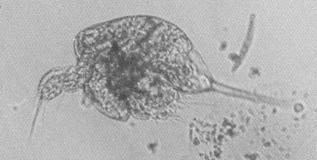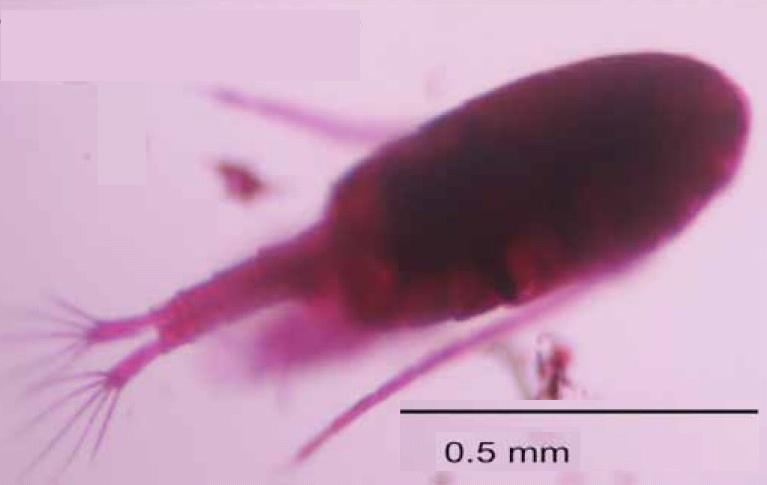Back to 115a - Back to content
COPEPODA, Copepods (subclass)
CALANOIDA, G.O.SARS 1903 (order)
Anterior part of the body much bigger than more than
twice length of the abdomen. First antenna long,
about as long as body, with more than 17 segments.
Fifth leg asymmetrical. Mostly with only one brood
sack.
Three (Two) species of calanoid copepods are endemic,
a somewhat remarkable occurrence considering that
calanoids are represented by only six (five) known
species in the Philippines and absent in many large
tropical lakes. (Mamaril, 2001a)“Copepods, specifically calanoid copepods, play an
important role in the productivity of aquatic
ecosystems since they serve as a crucial link
between primary producers and carnivores. In tropical
reservoirs and lakes, they are not only a major
source of food for many invertebrates and
zooplanktivorous fish, but also good biological
indicators. Calanoid/cyclopoid-cladoceran ratio
is used in limnological studies as an indicator
of water quality”. (Quotation: Palomar & Mamaril, 2001.)
PSEUDODIAPTOMIDAE, SARS 1902(family)
Inner branch (endopodit) of first, second, third and
fourth leg with 3 segments. Caudal branches more than
two times longer than wide.
PSEUDODIAPTOMUS, HERRICK 1884.
The genus primary coastal demersal species,
living near or on the bottom of lake or sea.
Broodsack bilobed in freshwater species.
A key to the 14 Philippine species of
Pseudodiaptomus is given by Walter (2006).
In big brackish waters like Laguna de Bay
Pseudodiaptomus can be of ecological
importance in "Inland waters". This is
the reason for including the family in the key.
See Walter (2009) – World of Copepods.
116 a. Second segment of left fifth leg of male
gives off two long spines of nearly equal
length and a third small one near the inner
junction of the succeeding segment. Apex of
male left endopod hook-like and bifid.
Urosome with lateral spines anteriorly.
Planktonic in fresh-, brachish- and seawater.
LOBUS-GROUP, POPPEI-SUBGROUP
- Luzon, Around Manila (no locality data, assumed
collected from freshwater (Wright, 1928)),
Taal Lake.
Pseudodiaptomus smithi, (WRIGHT, 1928)
[1928c, 1939b, 1986a, 2006]
116 b. Second segment of fifth leg of male gives off
one spine..................................................117
117 a. This spine shorter than the second segment.
Male right endopod large. Left endopodit
absent. Pediger (segment) five posterior
corners distally pointed. Marine species.
HYALINUS-GROUP- Luzon
Pseudodiaptomus trihamatus, WRIGHT, 1937
[1937c, 2006]
117 b. This spine longer than the second segment.
Apex of male left endopod hook-like and simple.
Pediger (segment) five with corners rounded.
LOBUS-GROUP, FORBESI-SUBGROUP.............................118
118 a. Second segment of left fifth leg of male
gives of one very slim spine longer than
the second segment. Exopodit lacking medial
pointed processes. Urosome without lateral spines.
In fresh-, brachish- and seawater.
Endemic.
- Naujan (Mindoro)– not found in 2012a, Taal (Luzon)
Pseudodiaptomus brehmi, (KIEFER, 1939)
[1938b, 1941, 2006, Taal: 2011c, -2012a]
Pseudodiaptomus brehmi from Taal Lake 2011. Photo Rey D.S.Papa.
UST, 2013
118 b. Second segment of left fifth leg of male gives
of one very broad spine longer than the second
segment, third segment gives off a smaller spine.
Exopodit medial with two pointed processes.
Urosome with one pair of lateral spines anteriorly.
Size female 1300 μm. In fresh, brakish and
sea-water (up to 3 ppt in Laguna de Bay in 1980).
(Figures 118b1, 118ba2, 118b3, 118b4, 118b5, 118b6,
118b7, 118b8,)
- Laguna de Bay (Nauplii, copepodit, female A+B, egg,
male,5th leg)Luzon Island, Calatagan, Batangas,
Provinse (marine in eelgrass), Panay Island
Pseudodiaptomus annandalei SEWELL, 1919
(syn. Pseudodiaptomus nostradamus BREHM, 1933)
[1933b, 1937e, 1939b (from Java), 1980, 1984a(nostradamus),
1986b, 2006 (annandalei)]

P. nostradamus Metanauplius from Laguna de Bay
P. nostradamus Male 5th legs from Laguna de Bay

P. nostradamus Male from Laguna de Bay
Some marine species, of Pseudodiaptomus, whereoff one can collect up to 10 congenic species at the same marine locality (coral reef) in the Philippine coastline. Se Walter (2006, 1986b) for further descriptions and a key of the Philippine marine species:
Pseudodiaptomus philippinensis WALTER, 1986 (Endemic).
Pseudodiaptomus bispinosus WALTER, 1984. (Endemic).
Pseudodiaptomus trispinosus WALTER, 1986 (Endemic).
Pseudodiaptomus terazakii WALTER, 2006.
Pseudodiaptomus caritus WALTER, 1986 (Endemic).
Pseudodiaptomus diadelus WALTER, 1986.
To 119a

